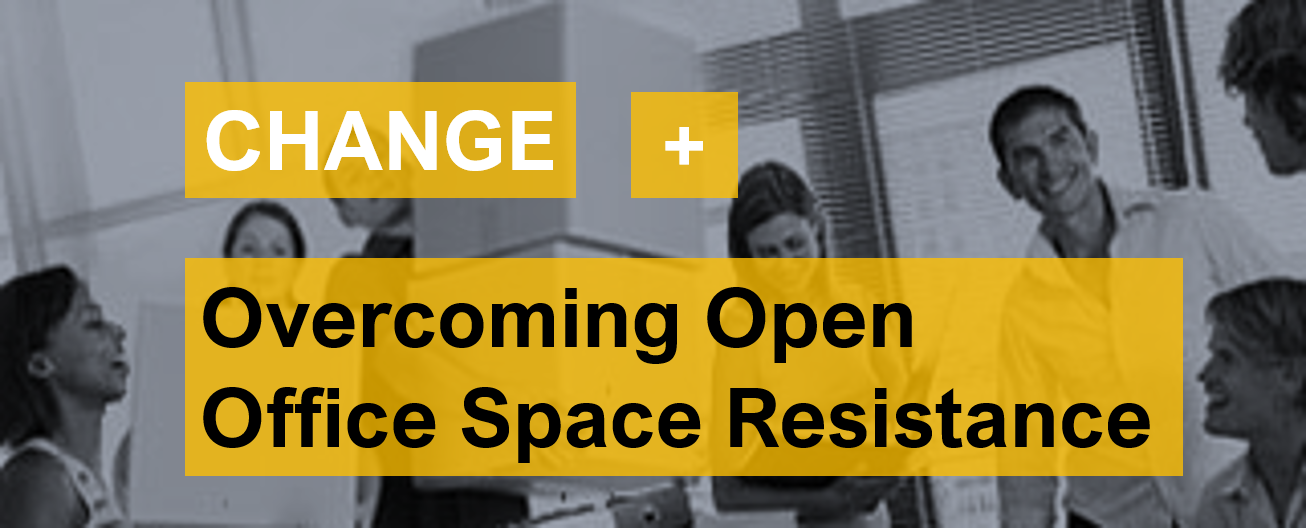Sign Up
Sign In
Blog

2018-11-08 11:05:22 Robert E. Smith, PhD, Founder, The Change Shop
I was reading a great article on people’s reactions to open office plans. It caught my attention because I know several people who are experiencing this shift first-hand and they don’t like it at all. Of course, this also got me thinking about the workplace change implications. What makes one company’s shift to open workspace a success while leaders at other organizations have to drag their team members kicking and screaming to the new “open” office? The difference, as you might’ve already guessed, rests in change leadership. Here’s how.
The Stuff that Makes Change Good or Bad
Researchers took an across-the-globe tour talking to people about what made their transition to open workspace good or bad. What emerged was the concept of ‘place identity’ which is how people feel about the place and space they are work in. When place identity is high, employees report more engagement in their work, more communication with their peers, and a stronger connection to the company. Incidentally, the characteristics of high place identity match, almost word-for-word, all the reasons executives at places like Google, Facebook, Genentech, IBM, and Microsoft give for wanting to move to open office plans. For instance, Facebook’s Chief People Officer said about the company’s 430,000 square-foot open office design, “It really creates an environment where people can collaborate; they can innovate together. There’s a lot of spontaneity in the way people bump into each other, just a really fun collaborative creative space.”
Conversely, research (and people like several of my friends) indicates that people with lower levels of place identity don’t like open workspaces and believe they create distractions, reduce privacy, and diminish motivation and satisfaction thanks to in part to unwanted noise. What’s more, the shift to open offices triggers two of the most common change resistance factors including:
Resistance factor #1 – “it used to work”: People thought that moving to the open offices would threaten their traditional ways of working with minimal distractions and interruptions. As one employee aptly put it, “The transition was difficult because we had a routine.”
Resistance factor #2 – “emotional attachment”: Leaders who were impacted by the move had to transition from private offices which conveyed status and power. One leader in China said, “I’ve been working my whole life to have my own office. Why would I want to sit with the team?”
In the case of the emotionally-attached leader highlighted above, the transition to open office space was not successful and he and his team ended up reverting back to traditional, cubicle-style workspaces demonstrating just how powerful change resistance can be.
Increasing Place Identity
So knowing that higher levels of place identity drive the benefits leaders are looking to achieve through open floor plans, the question is how to create it and improve it? The researchers gave 3 ways to increase place identify that closely follow the principles of good change management. Here’s a side-by-side comparison of the researchers’ recommendations in comparison to The Change Shop’s™ Impact, Influence, and Consistency (2IsC) model:
|
Recommendations for Improving Place Identity |
2IsC™ (Impact, Influence, & Consistency) Model Alignment |
|
Convey the Vision Beforehand: Leaders describe how the new space will help achieve the organization’s mission |
Impact: What needs to change is clear and understood by those who are impacted by it |
|
Encourage Workers to Adapt the Space to Their Needs: When workers believed they had the latitude to personalize the space, they felt more place identity |
Influence: The approach to the change is done in a way that increases team members' willingness to commit to new ways of doing things
|
|
Be Enthusiastic About the Space: Leaders’ attitudes about the space after the transition provides a critical source of information and affects whether employees believe the new physical environment can benefit their work |
Consistency: Those leading the change demonstrate role modelling and trust-building behaviors that increase support for the change
|
The research into open office transitions and research on change leadership reveals that change attitudes matter a lot when it comes to making successful transitions. How team members feel and the climate leaders create around changes at work have a significant influence on team members’ attitudes. This in turn affects mental resistance (I don’t think this is a good idea) and behavior resistance (I will say or do things that will show my unhappiness with this change).
When leaders demonstrate impact by creating a vision for and representing the workplace transition to open offices in a positive light, place identity flourishes but when they are neutral or negative, place identity suffers and workers were less likely to embrace the new office space. These findings serve as a strong business case for measuring and taking a pulse of leaders’ and team members’ attitudes at difference phases of the change process to gauge whether commitment levels are trending in the direction needed to have result in a beneficial outcome. Here are some tools that can help.
What are your experiences with the transition to open office space? Is attitude and leadership the key differentiator?
0
Comments